MCACN: Back for 2021 and muscled as ever
Welcome to the Muscle Car and Corvette Nationals, otherwise known as MCACN! As your tour guide, I will be giving you a tour of the impressive muscle that was on display late last month at the Donald E. Stevens Convention Center. This was an important show for 2021, particularly because last year the pandemic canceled the event. This year, Bob Ashton and his team of behind-the-scenes enthusiasts work to make up for lost time all while celebrating the 50th anniversary of the cars of 1971.

Let’s start the tour here at the entrance—here is a rather unusual 1970 Plymouth Road Runner. Why the goofy bird coming from the Air Grabber? Because this is the recently-found-and-restored car that was used in a popular advertisement in period. Notice the hood, which shows it to be equipped with the 440 six-barrel engine.
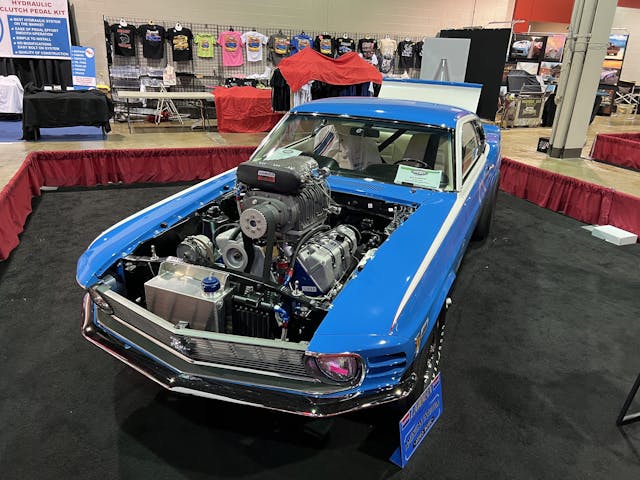

Next to the Road Runner is this 1970 Boss 429. Boss 429s are among the most desirable Mustangs, if not muscle cars, but this one is different even among Bosses: in 1970, this car was campaigned as the Lawman, performing for servicemen overseas as part of a cavalcade of promotional Ford vehicles that toured Southeast Asia. Besides putting on a show, Ford treated our troops to driving safety courses and other things to whet enthusiasts’ hope for what awaited them when they returned.
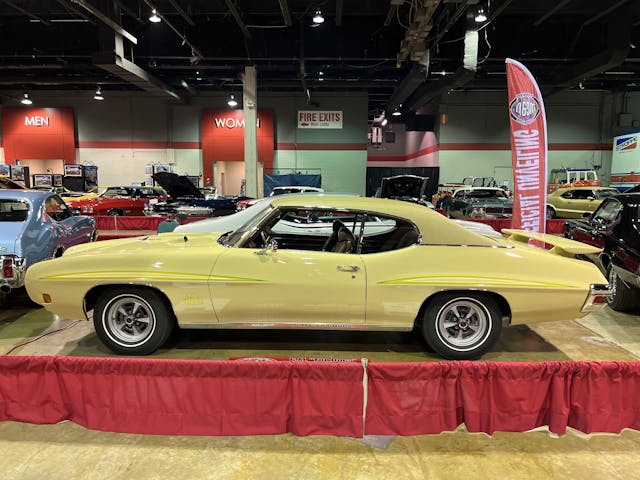
Continuing on to the GM “Top Dogs” display, we see that 1970 was a very significant year for General Motors performance cars. Previously, the big guys in the office upstairs forced each GM brand to limit cubic-inches to 400 cubic inches for anything other than full-size cars and the Corvette. In 1970 that edict was eliminated, giving GM’s performance cars an opportunity to compete cubic-inch-to-inch with Ford and Chrysler. As a result, 1970 can be seen as the high-water mark for General Motors performance offerings . . . well, except maybe Pontiac.

The Pontiac 455 was not developed for maximum performance the same way Buick and Oldsmobile’s 455 and Chevrolet’s 454 was. Why was this? Perhaps it was new management that wasn’t keen on performance the way John DeLorean was, or maybe it was because Pontiac had planned to introduce the Ram Air V (which never happened). Despite this, a 455 GTO like this convertible was no lightweight. This example is one of the few ordered with Ram Air as an option.

GTOs with the 400 carried Pontiac’s top performance banner in 1970. Any car equipped with the Ram Air III (standard on the Judge, like this one) and Ram Air IV had enough suds to bring a smile to most enthusiasts—think of them as the little engines that could. For 1970, 168 Judge convertibles like this one were built, with a handful in the signature Orbit Orange paint.

But don’t let that bright paint fool you, because the most famous “Goat” in this display is this striped silver hardtop because it is documented as being the actual car in the “Humbler” TV commercial introducing the 1970 GTO and demonstrating the vacuum-operated exhaust that Pontiac briefly offered. Baffles allowed the driver to modulate back pressure and, hence, exhaust tone, but it ran afoul of some state-government authorities and was discontinued mid-year.

The 455 was new for the 4-4-2 series in 1970, though Oldsmobile fans had a preview in 1968–69 with the Hurst/Olds. Like all of GM’s A-bodies, the F85/Cutlass series received a heavy, handsome facelift, with the Cutlass Supreme two-door hardtop and convertible receiving a unique roofline. Ram air induction ditched those scoops under the bumper and migrated to a new fiberglass hood, which then became optional on regular 4-4-2s. Several new colors like Rally Red were available for extroverts wanting to be noticed.
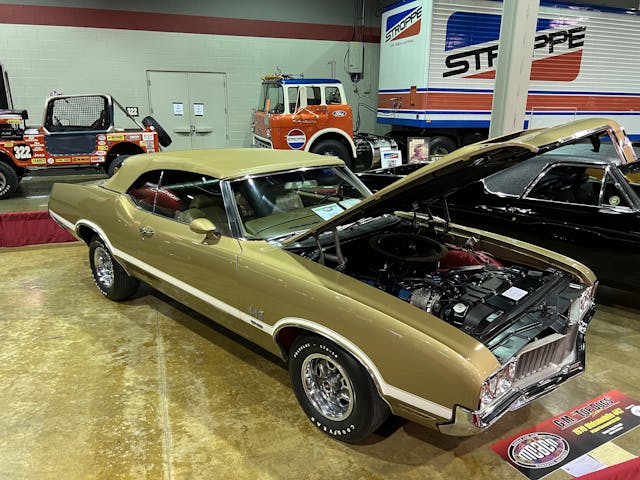
If you liked your 4-4-2 without a top, the body style was shared with the Cutlass Supreme convertible, giving the 4-4-2 series the possibility of both semi-fastback and notchback styling, which was unique among GM’s A-bodies. Add the W-30 package to the 4-4-2 and you’d have among the most desirable Oldsmobiles in its 100+ year history. Out of the 96 four-speeds made, precious few came with a split-bench seat like this one.

Buick had quietly been building torquey muscle for several years (though the reputation for high-speed cruisers developed in the 1930s), but the stars aligned for Buick in 1970. The GS series was reshuffled with the GS (formerly GS 350) and GS 455 (formerly GS 400), but it was the optional Stage 1 engine for the GS 455 that caught the attention of buff books and enthusiasts. Unlike other manufacturers, Buick engineered the engine for top performance out of the showroom, as the typical Buick customer didn’t get greasy like others. It wasn’t until the 1980s that the rest of the muscle car world learned what Buick fans already knew: The Stage 1 was capable of upstaging the heaviest of muscle machinery.

As we move on to this Stage 1 convertible (one of 232 built), this Gran Sport stands out more than others because it was ordered with a non-regular production color called Tealmist Gray, which was a color exclusive to the Riviera. For around $100 extra, the original buyer specified this color to make a very unique vehicle. Wouldn’t you rather have a Buick?

Over at Chevrolet, things operated similarly to how they did at Pontiac: keep the 396 (though adjusted to 402 cid) and introduce the 454. The L35 396/325 was ditched, making the 350-horse L34 standard and 375-horse L78 optional. After the model year began, the 360-horse LS5 454 was introduced, which was then followed by the 450-horse LS6 that replaced the L78. No car from the era was rated higher than the LS6. A convertible SS 454 with the LS6, like this Cranberry Red example, commands tons of prestige within the Chevrolet community and among general enthusiasts.

Need something hauled fast? The SS 454 package was not confined to hardtop and convertibles—it also was available for the El Camino, both in LS5 and LS6 forms. And see how this one doesn’t have stripes? Stripes were optional on both SS packages, but standard when Cowl Induction was ordered.

When it comes to hot Corvettes, 1970 strangely was not the year. In fact, for all the hubbub about the LS6, it never appeared in a 1970 Corvette. However, in 1971 appeared with 9.0:1 compression and 425 horsepower. Only 188 were built, with 12 having the road-racing ZR2 package like this one.

Back to Pontiac, we have an unusual attendee with the Grand Prix, which was more personal-luxury than muscle. Nonetheless, a 455 HO was available with 370 horsepower. With a four-speed, it’s a sleeper of a muscle car, and quite rare with 199 built. In some ways it foreshadowed what the mature performance enthusiasts would gravitate to a few years later.

Now let’s move on to the Class of 1970. It’s not just General Motors that enthusiasts think had its best year in 1970, so how about we take a gander at the market as a whole?

Chrysler introduced the all-new E-body: Challenger for Dodge, Barracuda for Plymouth. Now enthusiasts could have a proper Mopar pony car with the best engines in the line-up, all the way up to 440s and the Hemi. This Hemi Orange Challenger R/T was racer Bobby Isaac’s personal car, while the Top Banana car is an R/T SE, which was a luxurious edition of the R/T that included a vinyl top with smaller backlight, leather seating surfaces, and special trim. Notice there’s no stripes on this one—Dodge gave the buyer many ways to equip a Challenger R/T. To the right of that is a Vitamin C Hemi Cuda and a 500-mile Shelby GT500.

The Challenger was big news, in part because Dodge never had a pony car. These two are perhaps the most infamous because of their unique histories. The “Black Ghost” was a legendary Detroit street racer with the 426 Hemi, though it’s uniquely optioned with the “Gator Grain” top. The Hemi Orange car is known as “El Hemi” because it was bought new by a Venezuelan Chrysler engineer while working in Detroit, then went back to Venezuela in 1972 for 24 years. The son of the original owner is a long-time U.S. resident who brought the Challenger back to the States a number of years ago. The ET Team III wheels were added in the car’s youth, as was the “N94” hood.

Compare those cars with this sedate version, a regular Challenger that is not an R/T but is equipped like one thanks to the 383 four-barrel. The Gator Grain top adds to the allure, but if you look inside you’ll notice a three-speed shifter—unusual!

Chrysler’s B-bodies received a restyling so they appeared fresh for 1970, though a redesign would come the following year. The GTX continued as Plymouth’s upscale muscle car with standard 440 power. New was an Air Grabber vacuum-operated scoop that was flush with the hood when not operating. This GTX has the optional 440+6 and is painted in a color called Moulin Rouge.

Dodge’s version was called the Coronet R/T. The restyle was more polarizing, playing on the delta motif that Dodge had used since 1965. Was there a more aggressive look in the market? It lent itself well to a performance car, we’d say!

The Charger remained relatively unscathed in comparison, though designers added a loop bumper and fake scoops on the doors of R/Ts. The changes were enough to make all three years of this generation distinct, plus the 1970s featured more wild colors and new bucket seats with integrated head restraints, among other improvements that make the 1970 a favorite.

Over at Dearborn, Ford had a redesigned Torino, now with an even slicker “SportsRoof” fastback roofline. The Cobra became a Torino Cobra with a standard 429 4V while the Torino GT remained the upscale sporty model that was available with muscular options mimicking the Cobra’s. This one here is a Torino Cobra equipped with the 429 Cobra Jet and ram air, one of the optional engines for this model. But notice that Twister Special decal on the rear fender, as well as the long black stripe! This car is one of 90 used in a Kansas City promotion.

Mercury generally followed Ford’s lead but sometimes did things differently. This Competition Blue car is a 1970 Cyclone Spoiler, of which there was no Ford equivalent loaded for bear. Standard was the 429 Cobra Jet with ram air, which reflected an impressive list of standard equipment. Other Cyclone models was the base Cyclone and the Cyclone GT, but they were targeted at different enthusiasts at the time.

The Cougar Eliminator was similar to the Cyclone Spoiler in that stripes and spoilers defined it, and it was available in the same limited set of colors. Standard engine was a 351 Cleveland, with the 428 Cobra Jet being an option. Not only does this example have the latter, but it’s also equipped with the Drag Pack, making it a Super Cobra Jet. If that’s not enough, it was special-ordered in black.

It wasn’t just E-bodies that were new in the pony car world—Camaros and Firebirds were all-new for 1970. Now only available as a two-door hardtop, their introduction was delayed until February due to a UAW strike. The revamped Trans Am continued to feature a Ram Air III 400 standard and, unlike the GTO, the 455 never was available. Next to it is a Camaro Z/28, which now featured a 360-horsepower LT1 350.

The Super Sport continued, but 1970 was the first year where it started to fall out of favor with buyers. Standard continued to be a 300-horse 350, with a 350- and 375-horse 396 (402) being the only other choices. Only 600 of the latter were built, which was a big change from several thousand the year before.


If you think this looks like an Olds 4-4-2 W-30, you could be forgiven as this is a Cutlass S with the W-31 package, which included a 325-horse 350. These cars would give big-blocks a run for their money. Some people thought highly tuned small-blocks were the wave of the future but enthusiasts continued to gravitate to big-blocks. One of the unique features of W-Machines was this nifty W-27 aluminum rear axle that was available as an option. (Apparently this one scored 998/1000 in MCACN judging.)
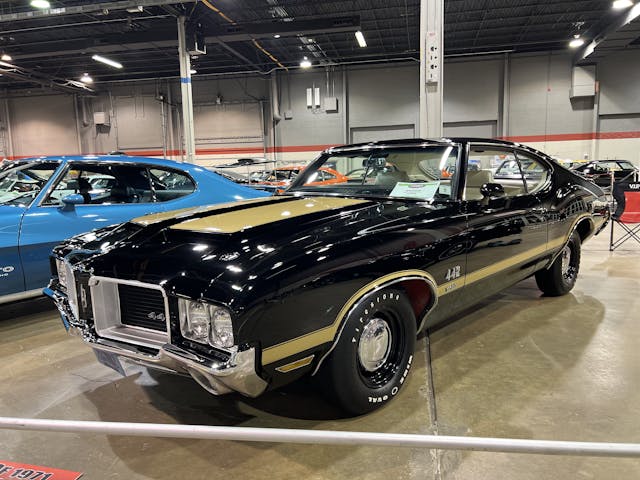
Nineteen seventy-one was a year of transition depending on the manufacturer. General Motors lowered compression across the board and trimmed many high-performance variants. Oldsmobile’s 4-4-2 still had a W-30 package, though horsepower fell by 20 to 350 thanks to 8.5:1 compression. The W-31 package for the F-85 and Cutlass S was discontinued.

The Pontiac GTO received a facelift that was somewhat polarizing, but notice how the air induction system was influenced by the Firebird Formula’s forward-thrusting scoops. What was interesting about the optional 455 was that while it was carried over into 1971 (down 35 horses to 325), a new 455 HO added the (then-discontinued) Ram Air IV’s round-port heads for 335 horses; however, despite the low compression, it was faster than 1970’s 455. Ram Air was an option for this engine, though this Goat doesn’t have it as evidenced by the lack of decals on the scoops.

The Mustang was all-new for 1971, clearly influenced by the 1969–70 Shelby. The 428 Cobra Jet was discontinued, replaced by the 429 Cobra Jet. While a powerhouse (especially with the Drag Pack), some diehards feel this 330-horse Boss 351 was the fastest of the bunch. While the regular 351 4V had compression cut a hair (and a loss of 15 horsepower to 285), a low-compression 280-horse 351 Cobra Jet was introduced mid-year that would carry the Ford high-performance torch through 1974.
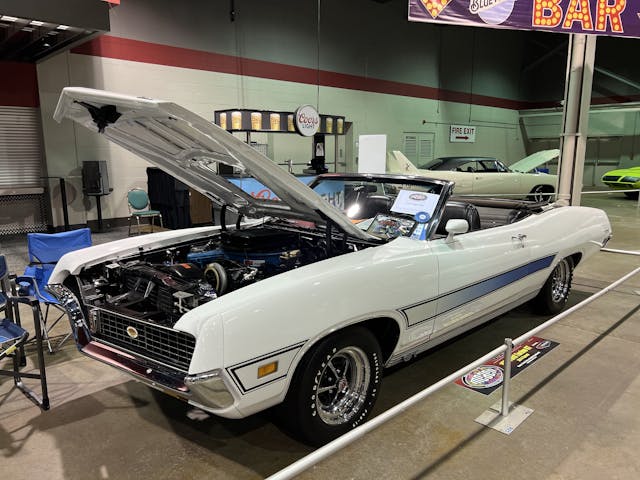
The Torino GT continued to handle mid-size duties for enthusiasts. 351 4V and 429 Cobra Jet options remained, as did the optional Shaker hood and “Laser” stripes. Unlike other brands, 1971 would be the last year for a hot mega-inch Ford. This one has the 351 backed by a four-speed, making it less than 100 built—yes, even engines lower in the totem pole declined severely in popularity.

Chrysler knew the end was near, which is why the 383 was detuned to 8.5:1 and 300 horsepower, but all other performance engines continued relatively unfettered (though the 440 featured a slight compression cut to 10.3:1 and a loss of five horses). All-new was the redesigned B-body, with the Dodge Charger being expanded to handle two-door duties for the Coronet. Pictured is the Charger R/T and, in the background, the Plymouth Road Runner. Which one do you prefer? Not only do both have the Hemi, but they also have the rare Elastomeric bumpers.

The Super Bee now was part of the Charger series for 1971. The 383 was standard, but mid-year the 340 was introduced. Note the Super Bee’s unique, standard hood, though the Ramcharger air induction system was available (and standard with the Hemi). This one has the standard bumper compared to the blue one but is unique because black was the only stripe color available, giving a “ghost stripe” effect.
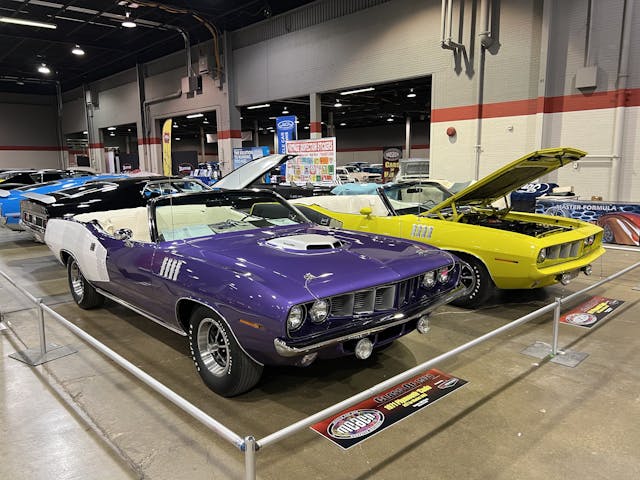
The Barracuda received a facelift that included quad headlights and a “cheese grater” grille that could be color-matched with certain hues. The performance ‘Cuda model also received non-functional fender extractors. Perhaps most controversial was the “Billboard” stripes, available in white or black. Total ‘Cuda convertible production was 374, with the In Violet ‘Cuda 383 featuring the standard bumper and Shaker air induction system while the Curious Yellow example features the standard twin-scooped hood and Elastomeric bumpers.

Next up is a 1970 Mustang Boss 302. A number of colors were available for this special homologation model, but black wasn’t one of them. Marti Auto Works has determined that 64 were special-ordered in a paint not on the palette, but this is the only Raven Black one known.

Nearby we see the legendary Hurst Under Glass 1968 Barracuda that is being hosted by its driver and fabricator, Bob Riggle. Though not the original one from the 1960s, this one is the Under Glass with the longest tenure of the bunch built since the 1960s.

Last year was the 50 anniversary of the Plymouth AAR Cuda and Dodge Challenger T/A twins. These were the homologation specials for the Trans-Am racing series. Though the race cars featured engines no larger than 5.0 liters, the street-going Mopars featured a 340 small-block with 3×2 carbs for 290 horsepower. Unique fiberglass hoods, striping, spoilers, and staggered tire sizes distinguished these cars from their respective Cuda and R/T brothers.

This red AAR Cuda demonstrates much of the “candy” that was available at the time. Notice the Elastomeric red bumpers, color-keyed side mirrors, and rear window louvers—this car has it all! The AAR’s strobe stripe is trick, as they used to say. Can you dig that?
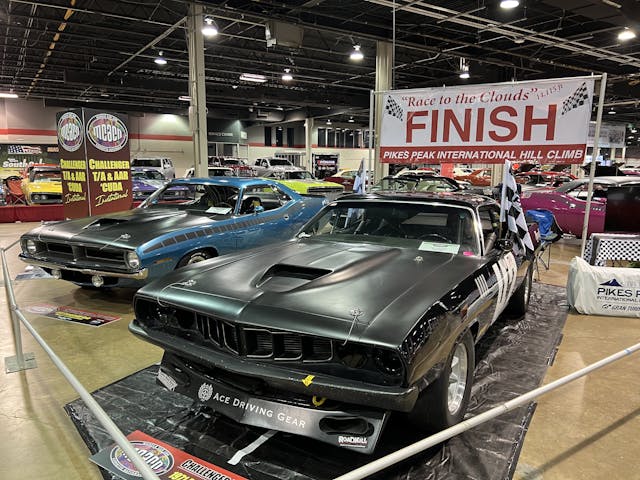
This blue AAR was originally bought by the company Olsonite, a Swedish supplier of steering wheels and plastic auto parts that also was a sponsor of Dan Gurney’s racing team. The black car is a latter-day ’71 Pikes Peak International Hill Climb racer inspired by the AAR.

The Challenger T/A’s major distinguishing feature was the trumpet exhausts exiting from the sides. Notice how “340 Six Pak” is spelled compared to the 440 Six Pack that was available for the Challenger R/T. Though Panther Pink (the same as Plymouth’s Moulin Rouge) tends to be among the rarest colors for a Mopar, the Challenger T/A is possibly one of the most common in this hue.

Let’s move on to the Cobra Jet display. The CJ was available as a 428, 429, and low-compression 351. This display included a little bit of everything in this lineage, including the 1970 Cougar Eliminator above.

Cobra Jet history begins with the “135” Mustang, so named because all of the 50 built in 1968 had 135 in their VIN sequence. All were white fastbacks, none with the GT package, built several months before production truly began. Twenty of the batch were built without seam sealer and sound deadener. Car #41 is one of those cars, one of three sent to Tasca Ford in Rhode Island. In fact, this is the car that Mario Andretti used in a match race and, irony of ironies, it’s had a 427 for most of its life. Over time this Mustang has acquired the hood stripe and side C-stripe that was a part of the regular production GTs with the Cobra Jet.

When the Cobra Jet reached regular production (which included the Cougar, Fairlane/Torino, and Comet/Montego/Cyclone), it became available on any Mustang GT, including coupes and convertibles. The most popular CJ in 1968 was the Shelby GT500KR, while a paltry 221 Mustang GT coupes were built.

The 428 Cobra Jet helped Ford’s image on the street, and the Fairlane-based 1969 Cobra model played the role of Ford’s mid-size image model AND competitor of the Plymouth Road Runner. Standard was the 428 CJ, though this one has optional ram air and the Drag Pack.
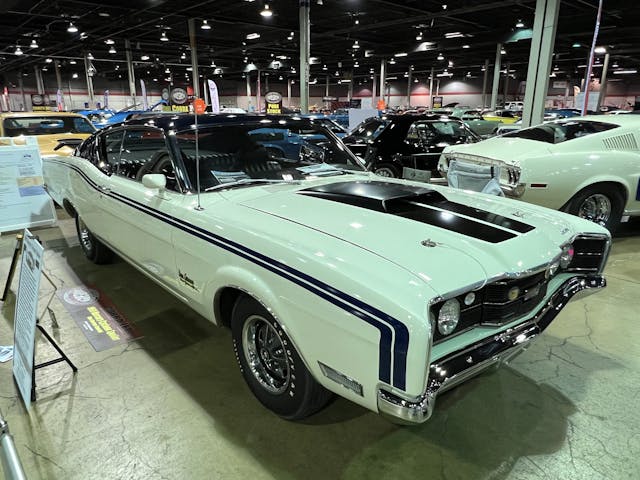
Mercury’s version of the Cobra was the Cyclone CJ, but mid-year you could buy this racing-inspired Cyclone Spoiler, available in Cale Yarborough (white/red) and Dan Gurney (white/blue) editions. Only 57 were built with the 428 Cobra Jet with ram air. The flush-nosed homologation special that you may have seen are often called the Spoiler II, but those only had a 351.

If you liked the Cougar and wanted to go racing, you’d order a base model (not the XR-7) with the 428 Cobra Jet and 4.30 gears courtesy of the Drag Pack. With an automatic transmission, only 24 other people did that. Since the NHRA factored this engine as 340 horses, and 360 with ram air, the original owner felt the Cougar would be more competitive without ram air and ordered it that way.
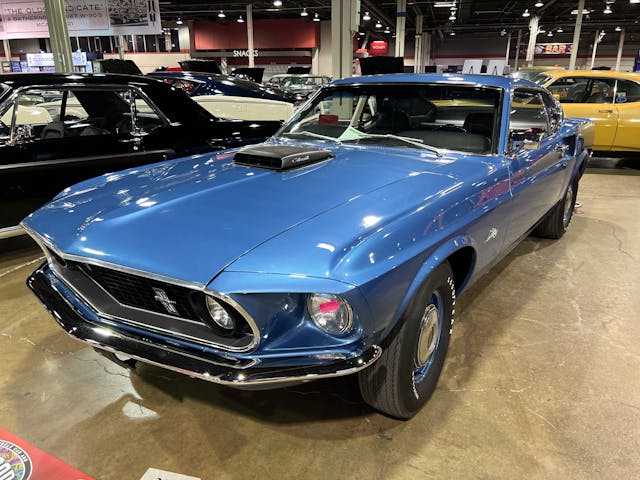
The 1969 Mach I was the image-car companion to the Cobra, but what image do you think is imparted by this plain SportsRoof? Cars without ram air received a flat hood, though this one was ordered with the Shaker, somewhat disrupting the Q-ship aspect of this vehicle. Do you prefer your cars dressed up or ready for business?
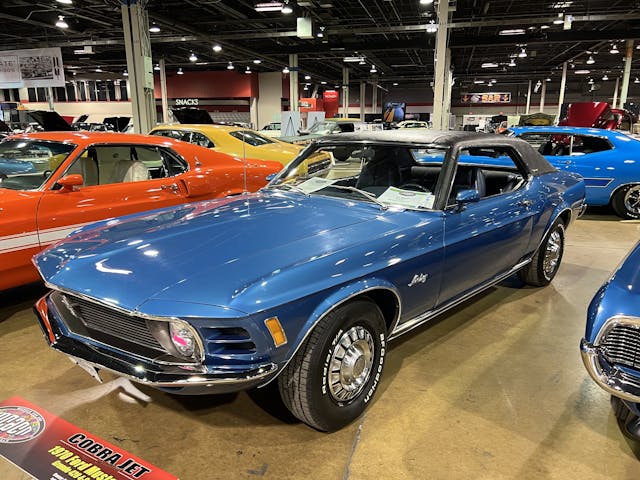
Speaking of the unusual side of Mustangs, the Mustang Grandé was introduced in 1969 as a luxurious pony car coupe. This 1970 Grandé is one of 14 built with the 428 Cobra Jet, but only one of those had a four-speed. If there is a true 1-of-1 car, this is it.

The 1970 Shelbys were leftover 1969s but with added black stripes on the hood and front spoiler. The GT500 featured a standard 428 Cobra Jet (GT350s had the new 351 Windsor) but only 98 featured the Drag Pack with 3.91 gears. The look was distinct from Mustangs but Ford was likely wise to put the special series of Mustangs to rest considering where the market was headed.

Remember that El Camino we saw earlier? Here’s the Ford version of that. The Ranchero GT’s engines mimicked the Torino GT’s, so things started with a 302 and only got interesting with the 351 4V and beyond. This original paint example has the 429 Cobra Jet without ram air plus the Drag Pack, making it one of 10 built. Why Ford distinguished between cars with and without ram air is anyone’s guess.

The 429 Cobra Jet was finally introduced for the Mustang (and Cougar) for 1971. Most were installed in the Mach I, but this car is one of 20 coupes built with the 429 CJ without ram air. Look how sedate 370 horsepower can appear! The convertible next to it is one of 32 built with the CJ and ram air, with nine having a four-speed. Some may think Mustangs are “belly-button” cars but the truth is the rarest Mustangs are as uncommon as anything else.

The standard engine for the Torino Cobra was downgraded to a 351 4V for 1971. Nonetheless, the 429 Cobra Jet was still available, including this Grabber Blue example with ram air. The Laser stripe, once proprietary to the Torino GT, was now available for the Cobra. After 1971, the high-performance 429 would be gone.

The Cyclone continued into 1971 with three distinct models, with the GT now featuring “GT” nomenclature in the gunsight of the grille. A 351 2V continued to be standard and were most popular, so 429 Cobra Jet cars like this are truly special—this “C-code” without ram air is one of 77 built.
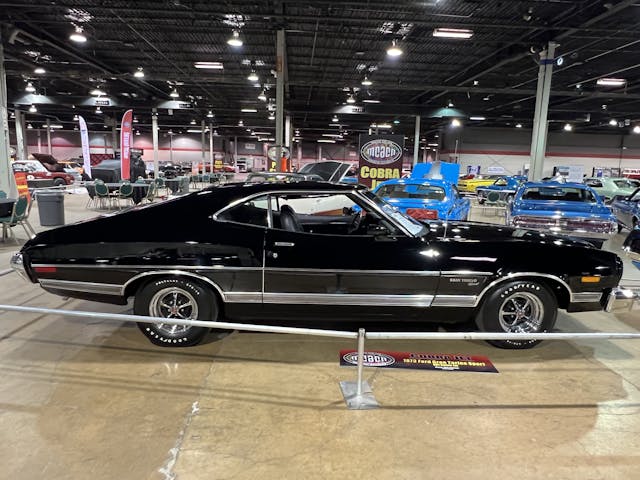
It may be hard to believe, but black was not a regular color on the roster for the 1973 Torino. The original owner of this Gran Torino Sport thought he’d correct the oversight with a special order, plus he added the 351 Cobra Jet for performance. This engine was rated at 246 net horsepower.
Eyes watering with the sheer majesty of MCACN 2021? Now’s a great time for a little break. We’ll resume more coverage of this fantastic show in another article to come soon.

